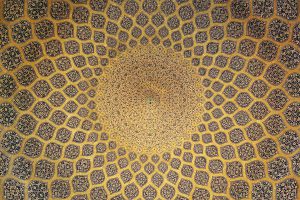Māwardī, Rūyānī, and the Term “al-Qāḍiyān” in the Shāfiʿī Madhhab

بسم الله الرحمن الرحيم
In the books that expound on the madhhab‘s nomenclature, the scholars discussed the term al-qāḍiyān. This term is the word al-qāḍī featured in its dual form; thus, it literally means “the two judges.” Some identified these two judges as Abū al-Ḥasan ʿAlī b. Muḥammad al-Māwardī (d. 450) and Abū al-Maḥāsin ʿAbd al-Wāḥid b. Ismāʿīl al-Rūyānī (d. 502). Moreover, they stated that they are intended when the term, al-qāḍiyān, is unqualified.
ʿAlawī al-Saqqāf,[1] Saqqāf b. ʿAlī al-Kāf,[2] ʿAbd al-Qādir al-Mandīlī,[3] Muḥammad Sahl Maḥfūẓ al-Ḥājīnī,[4] and others mentioned this. In many books, this is established nomenclature.
حيث يطلقون «القاضيين» فالمراد بهما الماوردي والروياني
When the Shāfiʿīyah use the term al-qāḍiyān, the intended meaning is Māwardī and Rūyānī.
It should be noted that another opinion exists on this issue. ʿAbd al-Ḥamīd al-Sharwānī related from Sayyid ʿUmar al-Baṣrī that it implies Qāḍī Ḥusayn and Qāḍī Abū al-Ṭayyib al-Ṭabarī.[5] ʿUmar al-Baṣrī’s opinion establishes that some did not consider it to imply Māwardī and Rūyānī; resultantly, there is a disagreement regarding who al-qāḍiyān are.
Māwardī, Rūyānī, and their books, al-Ḥāwī al-Kabīr and Baḥr al-Madhhab, hold an eminent status in the madhhab. Understanding who they are, as well as the significance of their works, will help one understand the term as it relates to them.
Māwardī studied fiqh in the city of Baṣrah under Abū al-Qāsim al-Ṣaymarī and then in the city of Baghdād under Shaykh Abū Ḥāmid.[6] Accordingly, Māwardī inherited his scholarly tradition from the Shāfiʿīyah of ʿIrāq. His teacher, Abū al-Qāsim al-Ṣaymarī, studied under Qāḍī Abū Ḥāmid al-Maruwarrūdhī who was the senior Shāfiʿī jurist in Baṣrah. And then, in Baghdād, Māwardī studied under the shaykh of the ʿIrāqī Ṭarīqah, Shaykh Abū Ḥāmid al-Isfarāyīnī.
Māwardī authored many priceless works. In the subject of fiqh, he authored a voluminous commentary on Mukhtaṣar al-Muzanī under the title al-Ḥāwī al-Kabīr. Māwardī’s Ḥāwī is an encyclopedic reference that comprehensively covers the madhhab. Ibn Khallikān said regarding it:
وله كتاب «الحاوي» الذي لم يطالعه إلا وشهد له بالتبحر والمعرفة التامة بالمذهب
He also wrote al-Ḥāwī. Anyone who reviews it will attest to his profound knowledge and thorough acquaintance with the madhhab.[7]
Then, there is Rūyānī. Rūyānī’s understanding of the Shāfiʿī Madhhab was vast and unparalleled. He once remarked regarding himself:
لو احترقت كتب الشافعي لأمليتها من حفظي
If the books of Imām Shāfiʿī would burn, I would be able to dictate them from memory.[8]
He studied fiqh under his father and his grandfather. He also studied under Muḥammad b. Bayān al-Kāzarūnī at Mayyāfāriqīn. Rūyānī’s grandfather studied under the shaykh of the Khurāsānī Ṭarīqah, Abū Bakr al-Qaffāl al-Marwazī. Thus, Rūyānī inherited his scholarly tradition from the Shāfiʿīyah of Khurāsān. Rūyānī was a prolific author; his most notable contribution is his magnum opus, Baḥr al-Madhhab.
To appreciate the significance of a term (i.e., al-qāḍiyān) being coined for both Māwardī and Rūyānī, one must understand the relationship these two scholars and their books have with each other. In Rūyānī’s biography, Ibn al-Subkī wrote:
ومن تصانيفه «البحر» وهو وإن كان أوسع كتب المذهب إلا أنه عبارة عن «حاوي» الماوردي مع فروع تلقاه الروياني عن أبيه وجده ومسائل أخر، فهو أكثر من «الحاوي» فروعا وإن كان «الحاوي» أحسن ترتيبا وأوضح تهذيبا.
From his books there is al-Baḥr, which is one of the school’s most comprehensive works. Rūyānī’s Baḥr is taken from Māwardī’s Ḥawī along with the jurisprudence that Rūyānī added which he took from his father and his grandfather. Rūyānī’s Baḥr includes more jurisprudence than Māwardī’s Ḥawī, however, Ḥawī has a better layout and presentation.[9]
From these passages, one may glean some pertinent facts regarding Māwardī and Rūyānī. Firstly, Māwardī is an ʿIrāqī. He studied with the leading Shāfiʿī scholars of ʿIrāq and penned a lengthy commentary on Mukhtaṣar al-Muzanī under the title al-Ḥāwī al-Kabīr. Rūyānī, on the other hand, is a Khurāsānī. In his Baḥr, Rūyānī relied on Māwardī’s Ḥāwī extensively; as well, he added to it from the jurisprudence he mastered under the tutelage of his shuyūkh, including his grandfather who is al-Qaffāl al-Marwazī’s direct student.
What transpired between Māwardī and Rūyānī greatly influenced the madhhab‘s jurisprudence. In the centuries that came after, the scholars evaluated the dynamics between them. Hereinafter, we shall mention the scenarios one may come across while engaging the opinions related from Māwardī and Rūyānī in the mutaʾakhkhirūn‘s fiqh books.
There are four scenarios. They are as follows:
Scenario One
Sometimes Rūyānī does not relate what Māwardī said.
Ibn al-Subkī wrote:[10]
قال في «الحاوي» في النهي عن تلقي الركبان وكذلك المدلس قال الشافعي -رضي الله عنه- قد عصى الله والبيع لازم والثمن حلال. يريد أن التدليس حرام والثمن حلال. وقد كان أبو علي ابن أبي هريرة يقول إن ثمن التدليس حرام لا ثمن المبيع ألا ترى أن المبيع إذا فات رجع على البائع بأرش عيب التدليس فدل على أنه أخذ منه بغير استحقاق. وما حكاه عن ابن أبي هريرة غريب ومعناه أن الزيادة بسبب التدليس محرمة لا جملة الثمن، واعلم أن صاحب «البحر» لم ينقل فيه هذا مع كثرة استقصائه لكلام «الحاوي».اه.
Scenario Two
Sometimes Rūyānī qualifies what Māwardī said.
Isnawī wrote:[11]
الصبي الذي لم يجرب عليه الكذب هل يقبل خبره؟ فيه خلاف عند الأصوليين وكذلك عند المحدثين والفقهاء والأصح عند الجميع عدم القبول، نعم إن احتفت به قرينة كالإذن في دخول الدار وحمل الهدية فالصحيح القبول، وإذا علمت ذلك فمن فروع المسألة…ومنها إذا أخبر لطلب صاحب الدعوة له فإن المدعو تلزمه الإجابة كما قاله الماوردي والروياني في «البحر» كلاهما في «باب الوليمة» إلا أن الروياني اشترط أن يقع في قلبه صدق الصبي.اه.
Scenario Three
Sometimes Rūyānī and Māwardī differ.
Ibn al-Ṣalāḥ wrote:[12]
وحكاه صاحب «بحر المذهب» وذكر أن صاحب «الحاوي» ذكر أن قول من قال إنه يلزمه هو مذهب الشافعي وجمهور أصحابه، قال: وقال أبو حامد: هذا هو المذهب، ولا أعرف ما حكي عن ابن سريج عنه ولا أجده في كتبه، وهو خلاف الإجماع أيضا. وذهب صاحب «البحر» بعد حكايته هذا إلى أن الصحيح هو أنه لا يلزمه.اه.
Scenario Four
Sometimes Rūyānī follows Māwardī.
Ramlī wrote:[13]
ومنه يؤخذ أنه لا فرق بين المصبوغ قبل النسج وبعده خلافا للماوردي في تقييده بما صبغ بعد النسج وإن تبعه الروياني.اه.
As well, Ibn al-ʿIrāqī wrote:[14]
ثانيهما قال الماوردي صورة الاكتفاء بالرؤية السابقة أن يكون ذاكرا لأوصافها حالة البيع فلو نسيها فهو كمن لم ير، وقال في «شرح المهذب» إنه غريب ولم يتعرض له الجمهور، قلت لكن تبعه الروياني فيه، وجزم به في «الكفاية»، وقال النشائي إنه ظاهر النص.اه.
Notably, in the last two examples, one may observe the due consideration that is given to places where Rūyānī follows Māwardī. This is apparent in the passage from Ramlī’s Nihāyah as well as the passage from Ibn al-ʿIrāqī’s Taḥrīr al-Fatāwī. The influence that the instances of their agreement, disagreement, etc., had on the madhhab‘s jurisprudence surely underlies the coinage of a specific term (i.e., al-qāḍiyān) for them.
Many maintained that al-qāḍiyān is nomenclature for Māwardī and Rūyānī. Still, one must ask regarding the prevalence of the term’s usage within the madhhab‘s corpus.
There are three ways that it (i.e., al-qāḍiyān) comes in our fiqh books: (1) it comes along with two qāḍīs who are both mentioned by name; (2) two qāḍīs are mentioned by name and thereafter al-qāḍiyān comes unqualified in the same passage; (3) al-qāḍiyān is unqualified and there is no mention of the two qāḍīs‘ names in the passage.
The term, al-qāḍiyān, frequently comes with explicit mention of the two qāḍīs. In these places, the term, al-qāḍiyān, is qualified. Some examples of this are:
– al-Qāḍiyān Abū Ḥāmid wa Abū al-Ṭayyib[15]
– al-Qāḍiyān Abū al-Ṭayyib wa al-Rūyānī[16]
– al-Qāḍiyān Ibn Kajj wa al-Rūyānī [17]
– al-Qāḍiyān al-Ṭabarī wa al-Rūyānī [18]
– al-Qāḍiyān Ibn Kajj wa al-Māwardī[19]
– al-Qāḍiyān Abū al-Ṭayyib wa Ibn Kajj[20]
– al-Qāḍiyān Abū al-Ṭayyib al-Ṭabarī wa Abū ʿAbdAllāh al-Ṣaymarī[21]
– al-Qāḍiyān Abū al-Ṭayyib wa Ḥusayn[22]
– al-Qāḍiyān Abū al-Ṭayyib wa Abū ʿAlī al-Bandīnijī[23]
– al-Qāḍiyān al-Ḥusayn wa al-Māwardī[24]
In these examples, eight scholars from the Aṣḥāb al-Wujūh (Māwardī, Rūyānī, Ḥusayn, Abū al-Ṭayyib, Abū Ḥāmid, Ibn Kajj, Ṣaymarī, and Bandīnijī) are mentioned, along with one of their colleagues, as al-qāḍiyān.
Then, an author may mention two scholars from the Aṣḥāb al-Wujūh. And, in the same passage, he will refer to them as al-qāḍiyān. For example, Isnawī wrote:
قوله ولو أقر الأب بعين مال لابنه فيمكن أن يكون مستند إقراره ما يمنع الرجوع ويمكن أن يكون مستنده ما لا يمنع الرجوع، وهو الهبة، وهل له الرجوع؟ عن أقضى القضاة الماوردي والقاضي أبي الطيب أنهما أفتيا بثبوت الرجوع تنزيلا للإقرار على أضعف الملكين وأدنى السببين كما ينزل على أقل المقدارين. وعن الشيخ أبي الحسن العبادي أنه لا رجوع لأن الأصل بقاء الملك للمقر له ويمكن أن يتوسط فيقال إن أقر بانتقال الملك منه إلى الآخر فالأمر كما قال «القاضيان» وإن أقر بالملك المطلق فالأمر كما قال العبادي.اه.
Thus, Isnawī mentioned both Māwardī and Abū al-Ṭayyib al-Ṭabarī by name. Thereafter, he referred to them as al-qāḍiyān.[25] There is another example of this found in one of Isnawī’s other books. He wrote:
قوله: وإن كان ما وجده مما لا يمكن حفظه، كالهريسة، والخيار فهو مخير بين أن يأكل وبين أن يبيع فإن أكل عزل قيمته مدة التعريف كما قاله الشيخ ثم ظاهر كلامه يقتضي أنه الذي يعزل القيمة، وإذا عزلها صارت ملكا لصاحب اللقطة كما صرح به «القاضيان» أبو الطيب والحسين وغيرهما وفي الرافعي أنه يرفع الأمر إلى الحاكم ليقبض عن صاحب المال. .اه. كلامه. وكلامه يوهم إيهاما كبيرا أن «القاضيين» قد صرحا بأنه الذي يعزل وليس كذلك فقد راجعت كلامهما معا فلم أجد فيهما إلا مثل عبارة الشيخ فينبغي أن يجعل التصريح راجعا إلى صيرورته ملكا وما يترتب عليه.اه.
In this passage, Isnawī cited from Qāḍī Abū al-Ṭayyib al-Ṭabarī and Qāḍī Ḥusayn; thereafter, he refers to them as al-qāḍiyān.[26] Instances in which an author cites from two qāḍis by name while using the epithet, al-qāḍī, in its dual form occur frequently. Instances in which an author cites from two qāḍis by name and in the same passage refers to them as al-qāḍiyān occur, however, this is comparatively infrequent.
Finding the term, al-qāḍiyān, altogether unqualified is more uncommon. The term is stated to imply Māwardī and Rūyānī; however, when the commentators on Minhāj cite them, they frequently mention them by name. In Tuḥfah and its ḥawāshī, one can find examples of this at the following places 3:357, 6:13, 6:143, and 9:294. In Nihāyah, one can find examples at 1:481, 2:24, 3:147, and 3:176. And in Mughnī, one can find examples at 1:355, 4:406, 5:198, and 5:275. In these places, one may observe the commentators citing from them by saying al-Māwardī wa al-Rūyānī or al-Rūyānī wa al-Māwardī.
It may be that the term al-qāḍiyān is not oft-used terminology. Some said that Māwardī and Rūyānī are intended by it. And others said that Qāḍī Ḥusayn and Abū al-Ṭayyib al-Ṭabarī are intended. Thus, the Shāfiʿīyah differ regarding the term’s meaning. In the madhhab‘s corpus, one will find that they generally mention Māwardī and Rūyānī by name rather than using the term for them.
And Allāh knows best.
[1] al-Fawāʾid al-Makkīyah, 193.
[2] Muʿjam fī Muṣṭalaḥāt Fiqh al-Shāfiʿīyah, 56.
[3] al-Khazāʾin al-Sanīyah, 117.
[4] al-Thamarāt al-Ḥājīnīyah, 17.
[5] Ḥāshiyat al-Tuḥfah, 1:353.
[6] Ṭabaqāt Ibn al-Subkī, 5:273.
[7] Wafayāt al-Aʿyān, 3:282.
[8] Muhimmāt 1:218; Ṭabaqāt Ibn Qāḍī Shuhbah, 1:287.
[9] Ṭabaqāt Ibn al-Subkī, 7:195.
[10] Ibid., 3:258.
[11] Tamhīd, 446.
[12] Sharḥ Mushkil al-Wasīṭ, 2:283.
[13] Nihāyat al-Muḥtāj, 3:272.
[14] Taḥrīr al-Fatāwī, 1:706.
[15] Bayān, 5:147.
[16] ʿAzīz, 5:143.
[17] Ibid., 10:49.
[18] Ibid., 11:116.
[19] Ibid., 12:109.
[20] Ibid., 12:378.
[21] Rawḍat al-Ṭālibīn, 1:18.
[22] Ibid., 3:386.
[23] Bidāyat al-Muḥtāj, 1:588.
[24] Ibid., 3:55.
[25] Muhimmāt, 5:599.
[26] al-Hidāyah ilā Awhām al-Kifāyah, 20:443.


